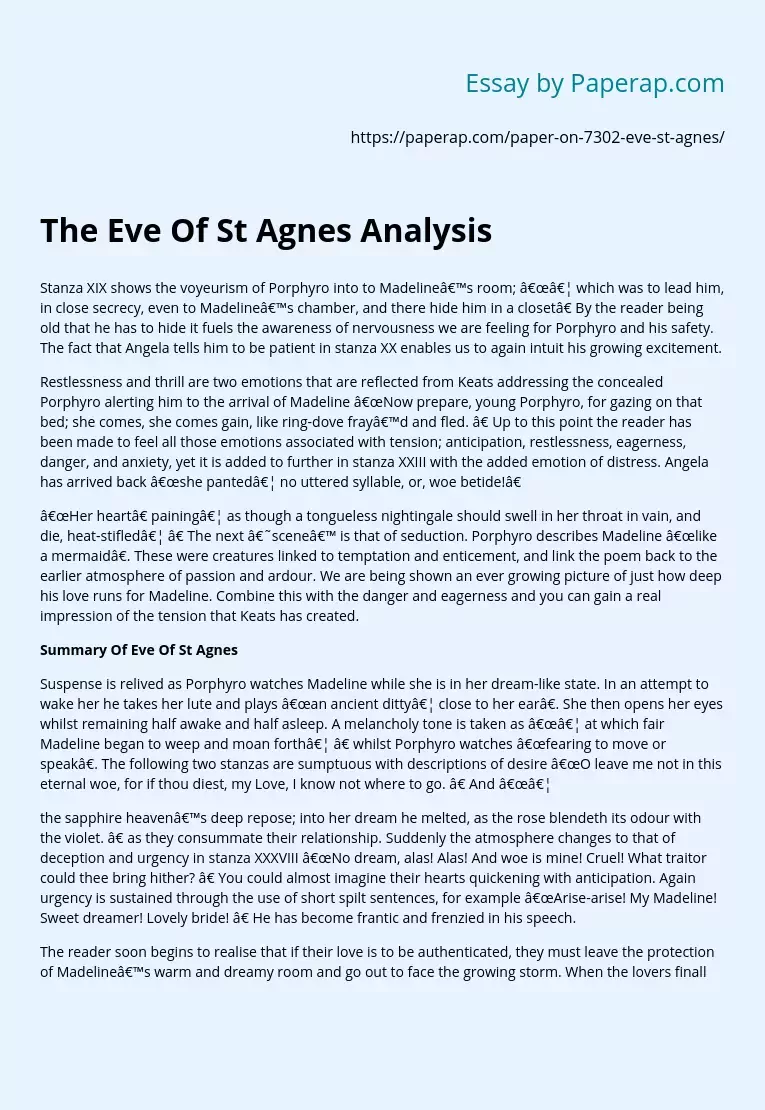The Eve Of St Agnes Analysis
Stanza XIX shows the voyeurism of Porphyro into to Madeline’s room; “… which was to lead him, in close secrecy, even to Madeline’s chamber, and there hide him in a closet” By the reader being old that he has to hide it fuels the awareness of nervousness we are feeling for Porphyro and his safety. The fact that Angela tells him to be patient in stanza XX enables us to again intuit his growing excitement.
Restlessness and thrill are two emotions that are reflected from Keats addressing the concealed Porphyro alerting him to the arrival of Madeline “Now prepare, young Porphyro, for gazing on that bed; she comes, she comes gain, like ring-dove fray’d and fled.
” Up to this point the reader has been made to feel all those emotions associated with tension; anticipation, restlessness, eagerness, danger, and anxiety, yet it is added to further in stanza XXIII with the added emotion of distress. Angela has arrived back “she panted… no uttered syllable, or, woe betide!”
“Her heart” paining… as though a tongueless nightingale should swell in her throat in vain, and die, heat-stifled… ” The next ‘scene’ is that of seduction.
Porphyro describes Madeline “like a mermaid”. These were creatures linked to temptation and enticement, and link the poem back to the earlier atmosphere of passion and ardour. We are being shown an ever growing picture of just how deep his love runs for Madeline. Combine this with the danger and eagerness and you can gain a real impression of the tension that Keats has created.
Suspense is relived as Porphyro watches Madeline while she is in her dream-like state. In an attempt to wake her he takes her lute and plays “an ancient ditty… close to her ear”. She then opens her eyes whilst remaining half awake and half asleep. A melancholy tone is taken as “… at which fair Madeline began to weep and moan forth… ” whilst Porphyro watches “fearing to move or speak”. The following two stanzas are sumptuous with descriptions of desire “O leave me not in this eternal woe, for if thou diest, my Love, I know not where to go. ” And “…
the sapphire heaven’s deep repose; into her dream he melted, as the rose blendeth its odour with the violet. ” as they consummate their relationship. Suddenly the atmosphere changes to that of deception and urgency in stanza XXXVIII “No dream, alas! Alas! And woe is mine! Cruel! What traitor could thee bring hither? ” You could almost imagine their hearts quickening with anticipation. Again urgency is sustained through the use of short spilt sentences, for example “Arise-arise! My Madeline! Sweet dreamer! Lovely bride! ” He has become frantic and frenzied in his speech.
The reader soon begins to realise that if their love is to be authenticated, they must leave the protection of Madeline’s warm and dreamy room and go out to face the growing storm. When the lovers finally make their escape, there is again a suggestion of haste and urgency. “They glide like phantoms, into the wide hall” By using the metaphor of the movement of a phantom it helps the reader establish just how quick yet cautious they had to be in their escape, thus aiding the sensation of tension. In stanza XLI Keats says how “the wakeful bloodhound rose…
” These are dogs that are associated with hunting, and in the context of the poem we can relate this to Porphyro. We can feel his apprehending danger. The last stanza is very significant in helping form my opinion on the statement in the question. Porphyro and Madeline have finally made it out of the house yet we are left with a slight sense of danger. This is resulting from the use of negative wording, such as ‘warrior’, ‘witch’, ‘demon’, ‘coffin’, ‘nightmared’ and ‘ashes’. Depending on your interpretation of the text, you could form the view that this ending does live up to the immense tension that is built up throughout the poem.
We know that they managed to get away from the house, yet all the negative connotations almost crate a sense of doom: you are left wanting to know what happens to the lovers. If you look at the ending in a different way then I think it is possible to believe that it is not a very dramatic departure from them; there is no celebration from them or any real indication of what happens to them. Some resolution is given by Angela and the Beadsman, but it is not to the level that you would expect.
The Eve Of St Agnes Analysis. (2019, Dec 05). Retrieved from https://paperap.com/paper-on-7302-eve-st-agnes/

